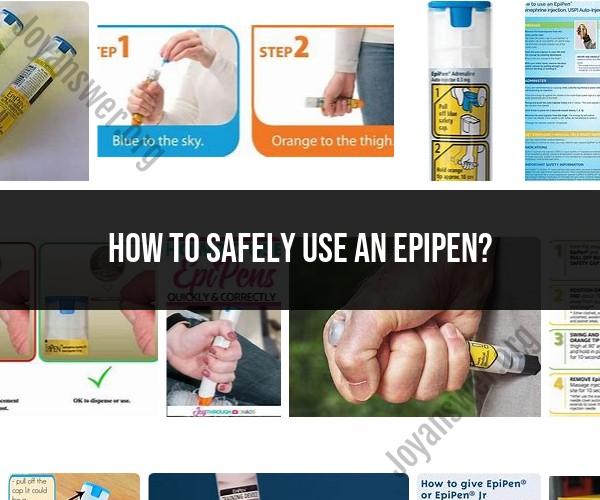How to safely use an EpiPen?
Using an EpiPen (epinephrine auto-injector) is a critical skill for individuals with severe allergies, as it can provide life-saving treatment in the event of a severe allergic reaction (anaphylaxis). Here are step-by-step instructions on how to safely use an EpiPen:
1. Prepare the EpiPen:
- Remove the EpiPen from its protective case or carrier tube. Hold it firmly with the orange (or colored) tip pointing downward.
2. Remove the Safety Cap:
- With your other hand, firmly grasp the blue (or colored) safety cap at the opposite end from the orange tip. Pull the safety cap straight off; do not bend or twist it.
3. Position Yourself:
- Stand or sit down, whichever is more comfortable, and make sure your thigh (outer part of the upper leg) is exposed and easily accessible.
4. Locate the Injection Site:
- Identify the injection site on your thigh. The EpiPen should be injected into the middle of the outer thigh. Avoid injecting into a vein or buttock.
5. Administer the EpiPen:
- Hold the EpiPen with the orange tip near the thigh, at a 90-degree angle to the thigh's surface.
6. Apply Pressure and Inject:
- Push the EpiPen firmly against the thigh until you hear and feel a click. This click indicates that the injection has started. The EpiPen needle will penetrate the thigh muscle automatically.
7. Hold in Place:
- Keep the EpiPen in place for about 3 seconds to ensure the full dose is delivered.
8. Remove the EpiPen:
- After the injection, carefully remove the EpiPen from the thigh. The needle will be covered by a safety shield to prevent accidental needlesticks.
9. Massage the Injection Site:
- Gently massage the injection site for approximately 10 seconds. This can help distribute the medication within the thigh muscle.
10. Seek Emergency Medical Attention:
- Even if symptoms improve after using the EpiPen, it is crucial to seek immediate medical attention. Anaphylaxis requires comprehensive evaluation and treatment.
11. Replace the Safety Cap:
- Once you have used the EpiPen, replace the blue (or colored) safety cap on the device.
12. Dispose of the EpiPen Safely:
- EpiPens are single-use devices. Discard the used EpiPen in a medical sharps container, following proper disposal guidelines for medical sharps.
Important Notes:
- Always carry two EpiPens with you, as severe allergic reactions may require a second dose.
- Check the expiration date regularly and replace expired EpiPens promptly.
- Make sure family members, friends, and close contacts know how to use an EpiPen in case of an emergency.
- After using an EpiPen, call 911 or seek immediate medical help, as the effects of epinephrine are temporary, and further treatment may be necessary.
- Follow up with your healthcare provider after using an EpiPen to address any underlying allergies or medical conditions.
Remember that using an EpiPen is a critical emergency response to anaphylaxis, and it should only be administered by individuals who have been prescribed and trained to use it. If you or someone you know has a severe allergy, consult with a healthcare professional to develop an anaphylaxis action plan and receive proper training on EpiPen use.
Using an EpiPen Safely: Step-by-Step Instructions
An EpiPen is an auto-injector that delivers a dose of epinephrine, a medication that can quickly reverse the symptoms of a severe allergic reaction (anaphylaxis). It is important to know how to use an EpiPen safely in case of an emergency.
Here are the step-by-step instructions for using an EpiPen:
- Remove the EpiPen from its carrier.
- Hold the EpiPen in your dominant hand with the orange tip pointing upwards.
- Place the orange tip firmly against the middle of the outer thigh (upper leg), through clothing if necessary.
- Press the orange tip firmly against the thigh until you hear a click.
- Hold the EpiPen in place for 3 seconds.
- Remove the EpiPen from the thigh.
- Massage the injection site for 10 seconds.
Call 911 immediately after using an EpiPen, even if the person feels better. The person will need to be monitored by medical professionals for at least 30 minutes after using an EpiPen to make sure that the allergic reaction does not recur.
EpiPen Administration: Ensuring Safe and Effective Use
Here are some important things to keep in mind when administering an EpiPen:
- Do not inject an EpiPen into the buttock, fingers, toes, or hands.
- Do not inject an EpiPen into a vein.
- If the person is unconscious, place them on their back with their legs elevated and call 911 immediately.
- If the person is having difficulty breathing, give them oxygen if available.
- If the person is vomiting, turn them on their side to prevent choking.
Emergency Allergy Treatment: How to Properly Use an EpiPen
If you are with someone who is having a severe allergic reaction, it is important to act quickly. Here are the steps to follow:
- Assess the situation. Is the person having difficulty breathing? Are they covered in hives or rash? Are they vomiting or experiencing diarrhea?
- If the person is having a severe allergic reaction, call 911 immediately.
- If the person has an EpiPen, help them to administer it.
- Stay with the person until help arrives.
By following these tips, you can help to ensure the safe and effective use of an EpiPen in an emergency situation.












